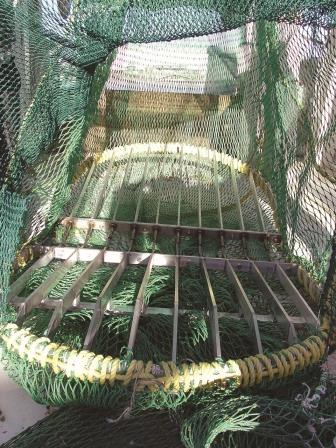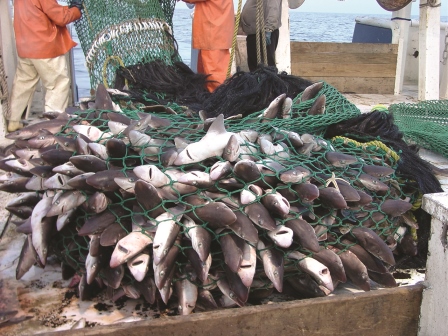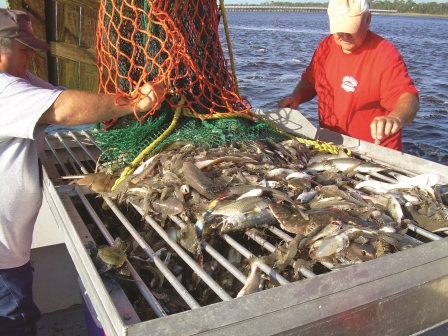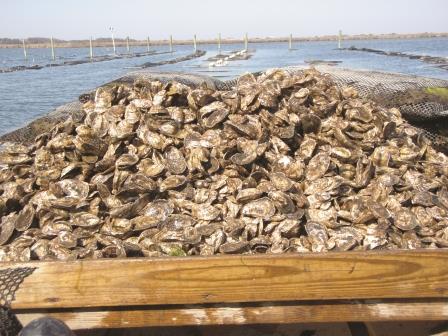Reworking Turtle Excluder Devices on Summer Flounder Trawls

In the winter, fishermen in the North Carolina summer flounder offshore fishery occasionally encounter endangered or threatened sea turtles while trawling for the fish. Trawlers want to avoid interactions with protected turtles because too many encounters can mean stricter fishing regulations in the future.
Sara Mirabilio, North Carolina Sea Grant fisheries extension specialist, tested new turtle excluder devices, or TEDs, for flounder bottomtrawl nets. She worked with Timothy Daniels of Graybeard’s Seafood who provided a trawler for the project. They wanted to determine if a change to the design of the TED — essentially a metal-frame grid — would improve the summer flounder catch while still keeping turtles out of nets.
This research was supported by the N.C. Fishery Resource Grant Program, or FRG, administered by Sea Grant. Because of the unusual confluence of turtles and flounder, the federal government changed offshore trawling rules in 1992. They started requiring bottom trawlers fishing for summer flounder in Atlantic offshore waters — south of Cape Charles, Va., to the North/South Carolina border — to carry TEDs to reduce the likelihood of capturing turtles in the net tailbag. The TED design, unchanged since the law was first implemented, was not ideal.
“It was good at excluding turtles but was horrible for catching flounder,” Mirabilio acknowledges. In a 2007 study off the Delmarva peninsula, researchers from the University of Rhode Island found a 35 percent flounder loss from nets equipped with a TED when compared to nets without the grid. Since then, several researchers have started studying possible modifications to the flounder TED.
For their project, Daniels and Mirabilio compared the Northeast modified flounder TED developed by Joseph DeAlteris from URI with the National Oceanic and Atmospheric Administration Fisheries Service’s large-frame TED, which now is the new standard TED.
They found that the URI TED had marginally better flounder retention rates and presented additional advantages over the large-frame TED.
Flounder TEDs are a combination of vertical bars spaced 4 inches apart on the top two-thirds of the grate and horizontal openings below. The upright bars keep out the turtles while the horizontal bars allow the bottom-swimming flounder to enter the net.
The Northeast modified TED adds additional horizontal openings at the bottom to allow in more flounder. It is taller and wider than the standard TED, and offers larger grid surfaces to reduce potential clogging that often causes loss of flounder catch.
Further, the URI TED can be rolled onto a net reel because it has two separate frame sections that are lashed together with heavy twine. The standard TED is one large piece of metal that cannot wrap around a net reel. It requires the net tailbag to be hauled up separately when the fishermen bring in the net.
“It’s safer, too, because you don’t have extra rope and a heavy metal frame hanging over your head. You don’t have extra hydraulic winches going that can snare limbs and clothing,” Mirabilio says. The fishermen preferred the simpler retrieval process.
“All things being equal, such as flounder catch and turtle escapement, they felt that the new design was more user- or fishing-friendly as far as being able to deploy it, install it in the net, retrieve it,” she adds. “All of that was an improvement, so even if the flounder catch was the same, they felt that the modified TED was a little bit better to work with.”

However, the data were not statistically conclusive on whether this was a better design. “This is definitely a step in the correct direction,” Mirabilio notes. “However, the TED design needs more tweaking and fine-tuning to create marked improvement in catch retention.”
The team also studied the bycatch to make sure that the updated TEDs did not become a factor in retaining other important commercial fish. “We regularly encountered sharks and rays as bycatch, but not a lot of other finfish and particularly not the species that everybody’s concerned about,” Mirabilio says.
But even the bycatch, particularly that of female dogfish, provided useful research data for other researchers. Mirabilio, who counted and weighed samples of the dogfish they caught, shared that data with Roger Rulifson, a biologist at East Carolina University, and his doctoral student Jennifer Cudney-Burch. They study the spiny dogfish population off the state’s coast.
“I will be comparing Sara’s data against the timing of dogfish detections in the Hatteras Bight and north of Cape Hatteras,” Cudney-Burch says. “Sara’s data are an important means of ground-truthing my results in my dissertation. They also show an important glimpse into what other fisheries are seeing with respect to dogfish bycatch.”
Although this project didn’t definitively solve the TED flounder-loss problem, Mirabilio praises the work and collaboration involved.
“It was a good example of industry-driven, cooperative research and what I’ve always viewed the FRG program to be about,” she says. “To me, it was a quintessential FRG project, trying to come up with win-win solutions to conserve species but still allow guys to fish.”
To read Mirabilio’s Fishery Resource Grant report, visit: www.ncseagrant.org and search for 09-FEG-09.
This article was published in the Holiday 2012 issue of Coastwatch.
For contact information and reprint requests, visit ncseagrant.ncsu.edu/coastwatch/contact/.


